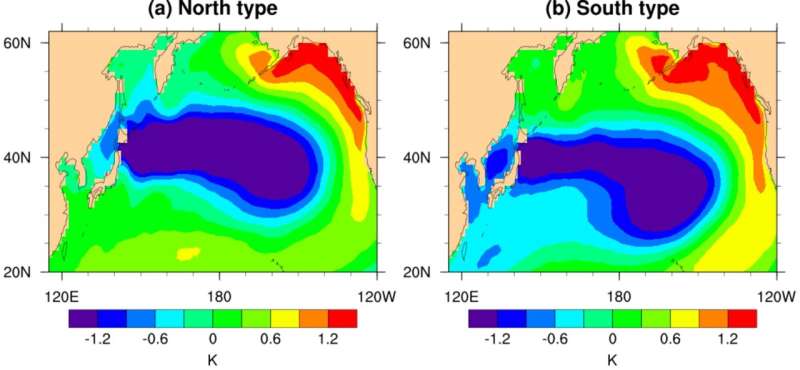This article has been reviewed according to Science X's editorial process and policies. Editors have highlighted the following attributes while ensuring the content's credibility:
fact-checked
peer-reviewed publication
trusted source
proofread
North or south? How sea surface temperature anomalies in the North Pacific can influence the Arctic polar vortex

Previous studies have found that phase changes in the sea surface temperature (SST) of the North Pacific can modulate the variations in the stratospheric polar vortex (SPV) in the Arctic, which is a circulation of winds high up in the stratosphere with strong impacts on regional weather patterns.
However, the influence of meridional (north–south) positional changes in North Pacific SST on SPV variations remains unclear. To address this knowledge gap, a study led by Prof. Wenshou Tian at Lanzhou University, China, used a combination of observed and simulated data to examine the dependence of SPV variations on the meridional positions of SST anomalies.
The results suggest that a relatively northward position of SST anomalies can more easily weaken the Arctic SPV compared to when the SST anomalies are positioned more to the south.
Mechanistically, the analysis indicates that, when the SST anomalies are positioned more to the north, the Aleutian low (a low pressure system located near the Aleutian Islands and one of the main centers of atmospheric circulation in the Northern Hemisphere) is located over the northern North Pacific, which serves to enhance the trough and subsequently weaken the SPV via a strengthening of the planetary-scale flow in the mid-to-high latitudes.
The weakened stratospheric circulation can then further extend downwards into the troposphere to favor negative surface temperature anomalies over the Eurasian region. By contrast, when the SST anomalies are positioned more to the south, the Aleutian low is also located more to the south, and its effect on the trough at high latitudes is relatively small. Thus, under these circumstances, the planetary-scale flow at higher latitudes is not strengthened, there is less of a weakening effect on the SPV, and Eurasian cooling is also less prominent.
"Our study suggests that the meridional position of North Pacific SST anomalies may be useful for predicting the strength of the Arctic SPV and therefore surface temperature variations in the Eurasian region," explains Prof. Tian. "Accordingly, besides the phase changes in North Pacific SST anomalies, their north–south positional changes must also be considered."
The study is published in Advances in Atmospheric Sciences.
More information: Tao Wang et al, The Influence of Meridional Variation in North Pacific Sea Surface Temperature Anomalies on the Arctic Stratospheric Polar Vortex, Advances in Atmospheric Sciences (2023). DOI: 10.1007/s00376-022-2033-2
Journal information: Advances in Atmospheric Sciences
Provided by Chinese Academy of Sciences



















